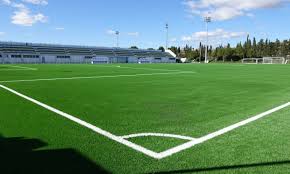

Si
The sports complex has a football field with bleachers on the north side of the field, a small indoor gym, a bar and four changing rooms.it
The gym is open every day of the year, except holidays. All categories train on the field during the week and there are matches on weekends.
In order to use the energy that comes from the sun, solar panels must be used. The panels capture photons, and these release electrons that generate the electric current. This must go through an inverter since the current we use is alternating current, and the one that comes out of the solar panel is direct. An electrical panel is installed to control the current of the different devices. In the centre, solar panels were installed to supply the demand of the indoor spaces. 168,510 Wp panels with an inclination of 31º were installed on the roof. To do this, we must know the location of the facility and the climate of the place (irradiation, peak solar hours...), as well as the energy demand of the installation. We must also know the surface available for their installation. To implement the sustainable solution, the following were needed: solar panels, batteries, charge regulators (optional), cables, protections, structure, labour, and maintenance. This sustainable solution works during the day, even without sunlight. If you want to use it at night, batteries must be used. Batteries are used for homes. They are not common in large buildings where demand is high.
Innovación técnica
100 000 €
25000 € de subvención de la U.E.
10
We save on our electricity bills.
We reduce our carbon footprint.
It improves the club's brand, as we promote clean energy.
The initial investment is high.
Maintenance costs.
| Indicador | Valor |
|---|---|
| Visitas por año | 55 |
| Consumo de agua (m³/visita) | 0 |
| Consumo de energía primaria por año (kWh/m2) | 2 500 |
| Ahorro de agua (%) | 0 |
| Ahorro de energía (%) | 0 |
| Ahorro de Residuos y Recursos (%) | 0 |
Optimización de la iluminación. Sustitución de luminarias tradicionales por tecnología LED de bajo consumo, para reducir el consumo energético en un 50-80%.

Última actualización: 29 de septiembre de 2024 a las 17:18